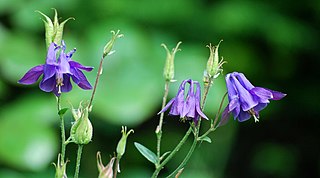
Aquilegia is a genus of about 130 species of perennial plants that are found in meadows, woodlands, and at higher elevations throughout the Northern Hemisphere, known for the spurred petals of their flowers.

Aquilegia formosa, the crimson columbine, western columbine, or (ambiguously) "red columbine", is a common wildflower native to western North America, from Alaska to Baja California, and eastward to Montana and Wyoming.

Aquilegia canadensis, the Canadian or Canada columbine, eastern red columbine, or wild columbine, is a species of flowering plant in the buttercup family Ranunculaceae. It is an herbaceous perennial native to woodland and rocky slopes in eastern North America, prized for its red and yellow flowers. It readily hybridizes with other species in the genus Aquilegia.
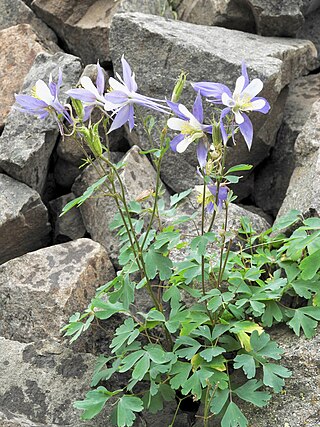
Aquilegia coerulea, the Colorado columbine, Rocky Mountain columbine, or blue columbine, is a species of flowering plant in the buttercup family Ranunculaceae, native to the Rocky Mountains and some of the surrounding states of the western United States. It is the state flower of Colorado. The Latin specific name coerulea means "sky blue".

Streptanthus glandulosus subsp. niger is an endangered subspecies of flowering plant within the family Brassicaceae. Like other genus members, this herb has wavy petal margins with perimeter calluses that discourage larval herbivory. This plant is endemic to the Tiburon Peninsula of Northern California, and occurs at elevations below 150 m on serpentine grasslands. The common name for this subspecies is Tiburon jewelflower or black jewelflower. This annual herb blooms in May and June and displays dark purple sepals. The etymology of this genus scientific name derives from the Greek word streptanthus, meaning twisted flower, with reference to the notable wavy margins of the petals. The subspecies name niger relates to the color of the seeds being black, although an alternate account cites the dark color of the petals as the source of the appellation.
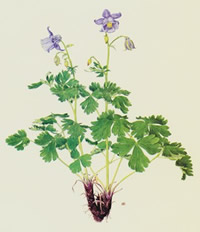
Aquilegia nuragica, commonly called Nuragica columbine, is a perennial flowering plant in the family Ranunculaceae. It is endemic to Italy, in a single canyon in the Supramonte mountain range on the island of Sardinia.
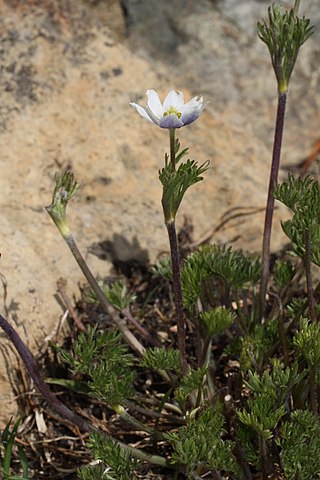
Anemone drummondii is a species of flowering plant in the buttercup family Ranunculaceae, known by the common name Drummond's anemone. It is native to mountains in western North America.
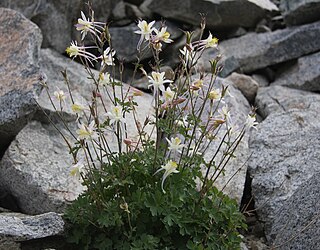
Aquilegia pubescens is a perennial flowering plant in the family Ranunculaceae, endemic to the Sierra Nevada in California. It is usually known by the common name Sierra columbine, and less frequently as the alpine columbine or Coville's columbine.

Potentilla daucifolia, commonly known as carrotleaf horkelia, is a species of flowering plant in the rose family. It is native to the Klamath Mountains and surrounding ranges in northern California and southern Oregon. It grows on mountain slopes and fields, often on serpentine soils.
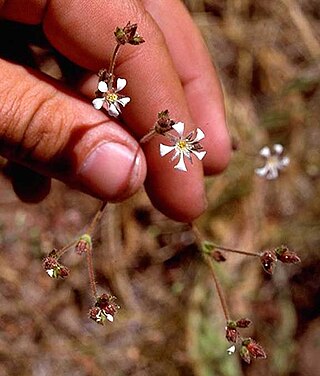
Potentilla pickeringii, also known as silky mousetail and Pickering's ivesia, is an uncommon species of flowering plant in the rose family. It is endemic to the Klamath Mountains of northern California where it is a plant of mountain meadows, often on serpentine soils.
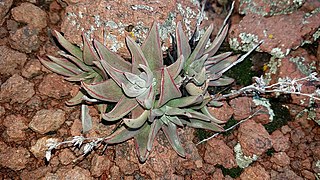
Dudleya abramsii is a species complex of succulent plants native to California and parts of Baja California. There are numerous subspecies, some critically endangered, with varying habits and lifestyles, but most often characterized by a smaller size, yellow flowers, and an affinity for rocky habitats. The subspecies may be polyphyletic.

Lithophragma parviflorum is a species of flowering plant in the saxifrage family known by the common name smallflower woodland star. It is native to much of western North America from British Columbia to California to South Dakota and Nebraska, where it grows in several types of open habitat. It is a rhizomatous perennial herb growing erect or leaning with a naked flowering stem. The leaves are mainly located low on the stem, each cut into three lobes or divided into three lobed leaflets. The stem bears up to 14 flowers, each in a cuplike calyx of red or green sepals. The five petals are bright white, up to 1.6 centimeters long, and usually divided into three toothlike lobes.
Silene serpentinicola is a rare species of flowering plant in the family Caryophyllaceae known by the common name serpentine Indian pink and serpentine catchfly.
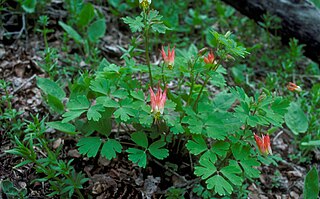
Aquilegia elegantula, the western red columbine, is a perennial species of flowering plant in the family Ranunculaceae, native to the Southwestern United States and northern Mexico.
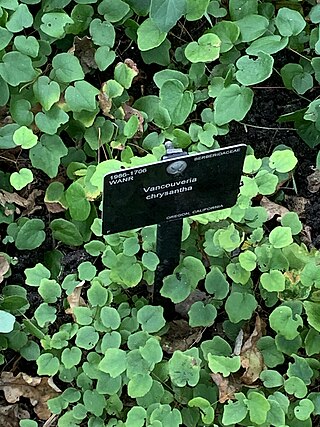
Vancouveria chrysantha is a species of flowering plant in the barberry family known by the common names golden inside-out flower and Siskiyou inside-out flower.

Aquilegia micrantha var. grahamii, common name Graham's columbine, is a variety of perennial flowering plant in the family Ranunculaceae, endemic to Utah in the United States.

Aquilegia fragrans, the fragrant columbine or sweet-scented columbine, is a perennial species of flowering plant in the family Ranunculaceae, native to the Western Himalayas.

Aquilegia ecalcarata, the spurless columbine or false columbine, is a perennial species of flowering plant in the family Ranunculaceae, native to central China.

Dudleya cymosasubsp. cymosa is a species of succulent perennial plant in the family Crassulaceae native to California. It is the autonymous subspecies for Dudleya cymosa, and is known by the common name canyon liveforever. It is native to the California Coast Ranges, the Sierra Nevada and the Santa Monica Mountains. It is characterized by bright-yellow, orange or red flowers and broad, wide leaves. This plant is commonly found growing on rocky outcrops, talus slopes, and in shaded canyons.
Aquilegia incurvata, or the Qinling columbine (秦岭耧斗菜), is a perennial species of flowering plant in the family Ranunculaceae, endemic to the Qinling mountain range in China.




















